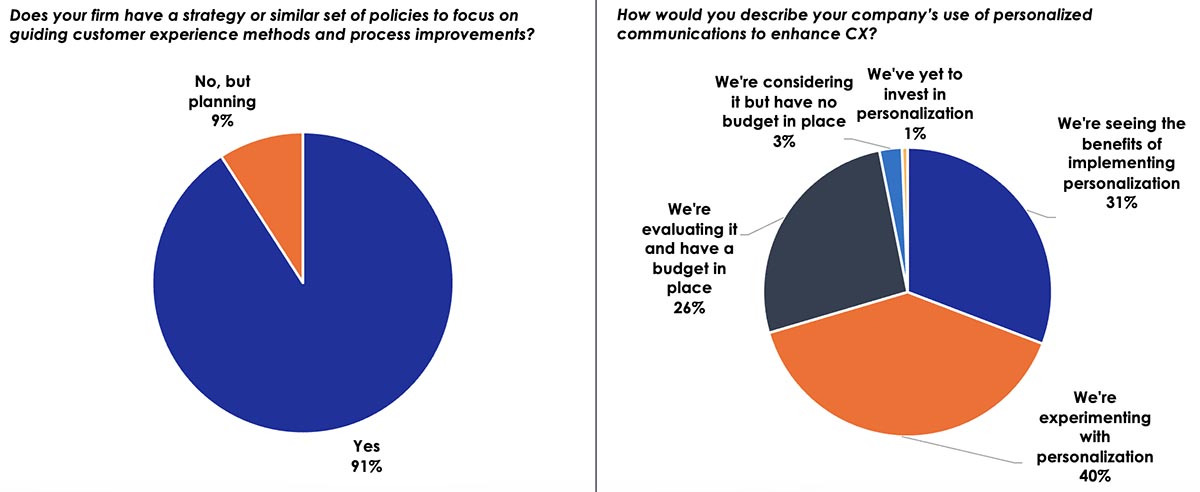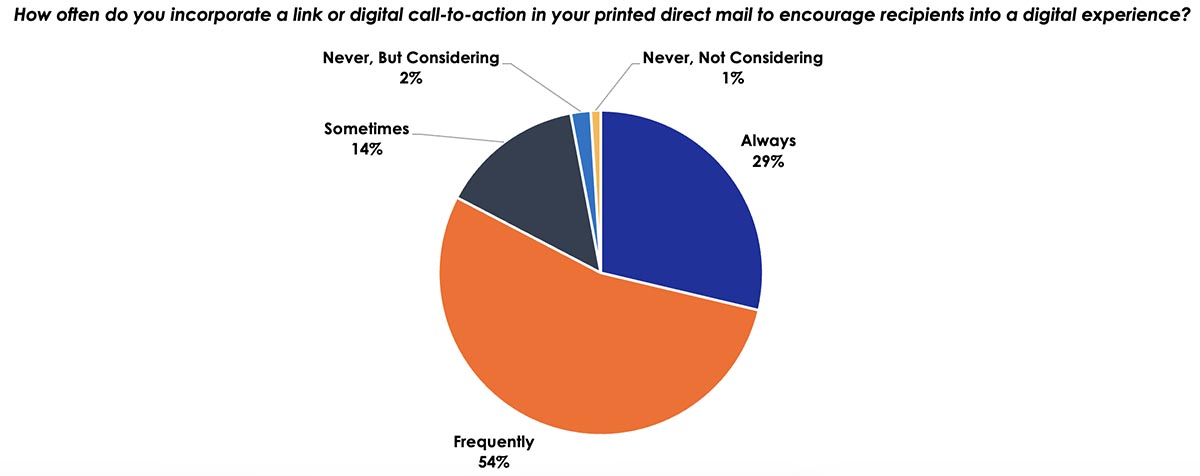- Companies continue migrating toward a digital-first mindset, but survey respondents report sending an average of nearly 2 million direct mail pieces to customers and prospects through the United States Postal Service every month.
- Highly personalized communications make a customer feel special and valued because they show that the sender is paying attention to their unique preferences.
- Seamlessly integrating printed and digital mediums can enable businesses to create a cohesive customer experience that resonates across all touchpoints.
By Karen Kimerer
Introduction
In today’s age of digital communications, businesses are increasing their use of online platforms to connect with their customers. Digital channels like text, e-mail, and online advertisements enable marketers to broaden their audience reach. It’s important to note, however, that printed materials still play a powerful role in customer communications. In fact, firms that are focused on customer experience (CX) have discovered an excellent harmony between digital and print channels.
Developing an integrated strategy is critical to success, particularly when your audience has diverse communication preferences and behaviors. Effective use of all channels, including print, fosters valuable customer connections and generates better business results. This article discusses how businesses can optimize the strengths of both digital and printed media to culminate more meaningful customer relationships.
The Power of Print
With the excessive volumes of digital messages flying around, many people may be left wondering if a real person actually wrote all those texts and e-mails they receive. Ongoing advancements in artificial intelligence (AI) make this thought cross our minds more now than it ever has before. This is precisely why print remains a powerful tool for customer communications, despite the digital revolution. Its tangible nature offers a sense of credibility and permanence—qualities that can be diluted in today’s deluge of digital messages.
In late 2023, Keypoint Intelligence surveyed hundreds of enterprise professionals to gain insight into how businesses are changing their direct marketing practices. Companies continue migrating toward a digital-first mindset, but survey respondents report sending an average of nearly 2 million direct mail pieces to customers and prospects through the United States Postal Service every month. A further inspection of how traditional direct mail is used in marketing campaigns suggests that direct mail will be around for a while. It's anticipated that the percentage of printed direct mail as a share of total direct marketing will remain relatively consistent over the next two years with only a slight shift toward digital marketing.
Enhancing the Experience: It’s About Personalization!
Today’s brand owners are obsessed with improving CX. According to Keypoint Intelligence’s research, connecting with customers can have an undeniable impact. It is worth noting that a heavy majority of total respondents already have a solid CX strategy in place. In addition, individualized messages are an extremely important component for improving CX.
Figure 1: Enhancing the Customer Experience

N = 318 Total Business Respondents
Source: Direct Marketing Communications Business Survey; Keypoint Intelligence 2023
When businesses tailor their interactions and offerings to align with an individual's preferences, it demonstrates that they are paying attention to each customer's unique needs and interests. This creates an opportunity to make the audience feel special and valued. Now that personalized communications are readily available, a warm greeting can create a sense of camaraderie and belonging. That said, it takes more than the simple use of a name to grab your audience's attention. Highly personalized communications make a customer feel special and valued because they show that the sender is paying attention to their unique preferences.
Reimagining Direct Mail’s Potential
Reimagining something involves looking at it from a new perspective and seeing it in a new light. To re-examine direct mail, you might change your assumptions about it, redefine its ultimate purpose, or explore its potential in a different way. If you break down the topic of direct mail into components and parts, you can reassemble them in a new way… and today’s leading marketers are doing just that! Keypoint Intelligence’s research reveals that digital links (e.g., QR codes, personalized URLs, augmented reality) in printed direct mail are rising in popularity. In fact, 83% of respondents use digital calls-to-action always or most of the time.
Figure 2: Incorporating Digital Calls-to-Action in Printed Direct Mail

N = 318 Total Business Respondents
Source: Direct Marketing Communications Business Survey; Keypoint Intelligence 2023
Digital links bring a new dimension to printed direct mail and encourage recipients to engage with it. In relation to static mail campaigns, respondents reported an increase of nearly 9% in response rates when a link or digital call to action is used. Gone are the days of dialing the phone numbers printed on a postcard or manually typing in a provided URL. A quick scan of a well-crafted direct mail piece can instantly connect recipients with your brand and its offerings.
By properly coordinating digital and print channels to work together, you can create more effective customer communications. Seamlessly integrating these two mediums can enable businesses to create a cohesive customer experience that resonates across all touchpoints. As a result, the conversation must shift from weighing the advantages of printed direct mail over online marketing and vice versa. Instead, you must focus on your goal and then define a strategy to get there.
Each communication channel uniquely impacts important marketing efforts like customer retention, referral collection, or reactivating lapsed customers. While some channels are more widely used to cross-sell and upsell, marketers often lean on printed direct mail for brand awareness and new customer acquisition. The point is that all channels—whether it’s e-mail, direct mail, SMS/text, online advertising, or social media—play a vital role in the results of a well-designed marketing campaign. Most marketers rely on multiple channels to support their CX efforts, and this is why printed direct mail will continue to play an important role in customer communications.
If you need further proof that direct mail draws attention, consider that major brands like Amazon, Wayfair, and Thread-Up have live print campaigns that are active across the county. Interestingly, none of the aforementioned brands has a physical store that customers can visit. Even firms with a digital first mindset are reimagining how print can grab their audience's attention and quickly direct them online to make a purchase.
The Bottom Line
In today’s rapidly evolving world of communications, it's easy to overlook the enduring impact of print marketing. There is no question that digital channels have truly transformed the landscape, but printed direct mail campaigns remain effective when used correctly. The hesitance to embrace print is often due to isolated instances of ineffective and costly campaigns. When employed strategically, direct mail campaigns can deliver a powerful punch. Printed pieces with high-quality color images, strongly personalized messaging, and integrated digital links can effectively capture attention, convey information, and drive action.
As part of the Business Development Strategies Consulting Service at Keypoint Intelligence, Karen Kimerer has experienced the many challenges of expanding current market opportunities and securing new business. She has developed a systematic approach to these opportunities, addressing the unique requirements of becoming a leader in our changing industry.














